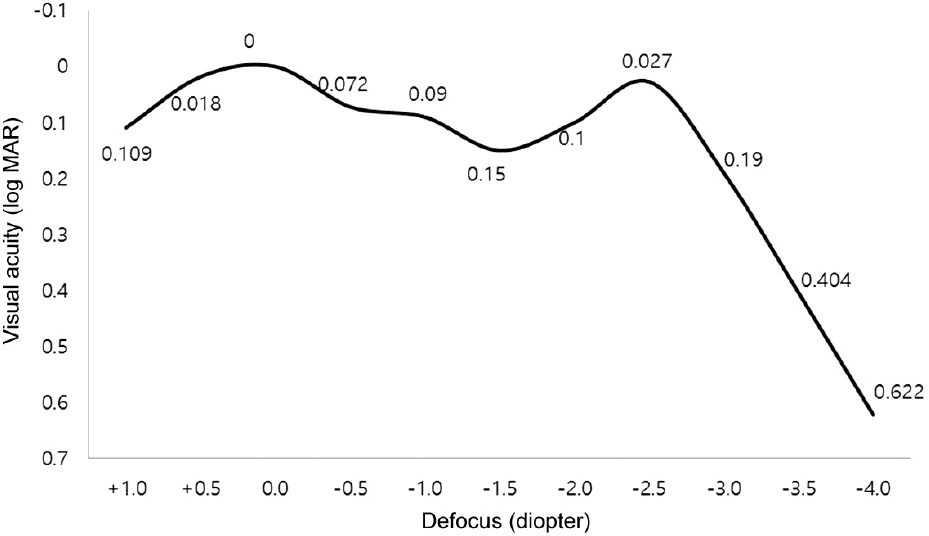J Korean Ophthalmol Soc.
2015 Sep;56(9):1331-1337. 10.3341/jkos.2015.56.9.1331.
Clinical Outcomes of Diffractive Trifocal Intraocular Lens in Both Eyes: A 6-Month Follow-Up
- Affiliations
-
- 1Department of Ophthalmology, Kyungpook National University School of Medicine, Daegu, Korea.
- 2Metro Eye Center, Daegu, Korea. eyedr.lee@gmail.com
- KMID: 2214546
- DOI: http://doi.org/10.3341/jkos.2015.56.9.1331
Abstract
- PURPOSE
To evaluate clinical outcomes after cataract surgery with bilateral implantation of the diffractive trifocal intraocular lens (IOL).
METHODS
Forty-four eyes of 22 patients were analyzed in the present study from July 2014 to December 2014. Phacoemulsification with bilateral implantation of an AT Lisa tri 839 MP IOL (Carl Zeiss Meditec, Jena, Germany) was performed. Over a 6-month follow-up, the main outcome measures were uncorrected distance visual acuity (UDVA), uncorrected intermediate visual acuity (UIVA) at 80 cm, uncorrected near visual acuity (UNVA) at 40 cm, and spherical equivalent refraction. Visual quality and patient satisfaction were evaluated using a Quality of Vision questionnaire. Finally, the defocus curve was measured.
RESULTS
The mean monocular UNVA, UIVA, and UDVA were 0.23, 0.22, and 0.02 log MAR at 1 month, 0.21, 0.20, and 0.01 log MAR at 3 months and 0.20, 0.22, and 0.01 log MAR at 6 months postoperatively, respectively. The mean binocular UNVA, UIVA, and UDVA were 0.16, 0.12, and 0.0 log MAR at 1 month, 0.15, 0.11, and 0.0 log MAR at 3 months and 0.15, 0.13, and 0.0 log MAR at 6 months postoperatively, respectively. Twelve patients reported glare and 17 patients reported halo. Defocus curve showed best visual acuity results at 0.0 D and second peak at - 2.5 D. The intermediate-vision values were stable.
CONCLUSIONS
Diffractive trifocal IOL provided excellent distance, intermediate, and near visual outcomes.
Keyword
MeSH Terms
Figure
Cited by 1 articles
-
Myopic Shift after Implantation of a Novel Diffractive Trifocal Intraocular Lens in Korean Eyes
Sungsoon Hwang, Dong Hui Lim, Joo Hyun, Myoung Joon Kim, Tae-Young Chung
Korean J Ophthalmol. 2018;32(1):16-22. doi: 10.3341/kjo.2017.0060.
Reference
-
References
1. Blaylock JF, Si Z, Vickers C. Visual and refractive status at differ-ent focal distances after implantation of the ReSTOR multifocal in-traocular lens. J Cataract Refract Surg. 2006; 32:1464–73.
Article2. de Vries NE, Nuijts RM. Multifocal intraocular lenses in cataract surgery: literature review of benefits and side effects. J Cataract Refract Surg. 2013; 39:268–78.
Article3. Mester U, Hunold W, Wesendahl T, Kaymak H. Functional out-comes after implantation of Tecnis ZM900 and Array SA40 multi-focal intraocular lenses. J Cataract Refract Surg. 2007; 33:1033–40.
Article4. Woodward MA, Randleman JB, Stulting RD. Dissatisfaction after multifocal intraocular lens implantation. J Cataract Refract Surg. 2009; 35:992–7.
Article5. Lee HS, Park SH, Kim MS. Clinical results and some problems of multifocal apodized diffractive intraocular lens implantation. J Korean Ophthalmol Soc. 2008; 49:1235–41.
Article6. Retzlaff JA, Sanders DR, Kraff MC. Development of the SRK/T intraocular lens implant power calculation formula. J Cataract Refract Surg. 1990; 16:333–40.
Article7. John Shammas H. Intraocular lens power calculations, 1st ed. New Jersey: Slack Inc.,. 2003; 41–57.8. McAlinden C, Pesudovs K, Moore JE. The development of an in-strument to measure quality of vision: the Quality of Vision (QoV) questionnaire. Invest Ophthalmol Vis Sci. 2010; 51:5537–45.
Article9. Mojzis P, Peña-García P, Liehneova I. . Outcomes of a new dif-fractive trifocal intraocular lens. J Cataract Refract Surg. 2014; 40:60–9.
Article10. Law EM, Aggarwal RK, Kasaby H. Clinical outcomes with a new trifocal intraocular lens. Eur J Ophthalmol. 2014; 24:501–8.
Article11. Marques EF, Ferreira TB. Comparison of visual outcomes of 2 dif-fractive trifocal intraocular lenses. J Cataract Refract Surg. 2015; 41:354–63.
Article12. Sheppard AL, Shah S, Bhatt U. . Visual outcomes and sub-jective experience after bilateral implantation of a new diffractive trifocal intraocular lens. J Cataract Refract Surg. 2013; 39:343–9.
Article13. Cochener B, Vryghem J, Rozot P. . Clinical outcomes with a trifocal intraocular lens: a multicenter study. J Refract Surg. 2014; 30:762–8.
Article14. Ruiz-Alcocer J, Madrid-Costa D, García-Lázaro S. . Optical performance of two new trifocal intraocular lenses: through-focus modulation transfer function and influence of pupil size. Clin Experiment Ophthalmol. 2014; 42:271–6.
Article15. Alfonso JF, Fernández-Vega L, Ortí S. . Differences in visual performance of AcrySof ReSTOR IOL in high and low myopic eyes. Eur J Ophthalmol. 2010; 20:333–9.
Article
- Full Text Links
- Actions
-
Cited
- CITED
-
- Close
- Share
- Similar articles
-
- Comparison of the Visual Outcomes after Cataract Surgery with Implantation of a Bifocal and Trifocal Diffractive Intraocular Lens
- Clinical Outcomes of Diffractive Aspheric Trifocal Intraocular Lens Implantation
- Trifocal versus Bifocal Diffractive Intraocular Lens Implantation after Cataract Surgery or Refractive Lens Exchange: a Meta-analysis
- Comparison of Reading Speed after Bilateral Bifocal and Trifocal Intraocular Lens Implantation
- Pseudoaccomodation in Pseudophakic Eyes with 3M Multifocal Intraocular Lens




